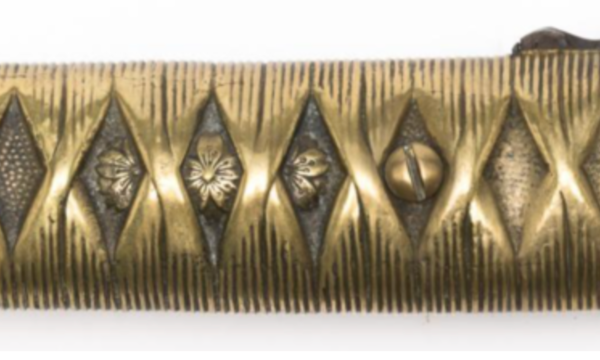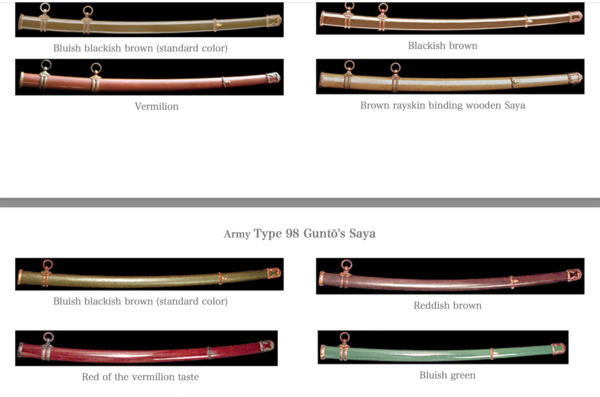
John C
Members-
Posts
2,210 -
Joined
-
Last visited
-
Days Won
15
Everything posted by John C
-
P.A. Just a minor note. I think Gilles is correct that the belt has some age to it. It appears to me the thread used on the belt is a cotton or burlap weave. If it were a modern repro, it would certainly have been sewn with polyester thread since it is more readily available. You can also see a minor bit of fraying. John C.
-
Agreed. I have both, with the majority being on the blade. The photo in the second post is one for sale in Japan with the same signature. Maybe it was his thing? Below is another one, which I believe has the same last kanji. John C.
-
Here is the link to the completed auction. https://www.ebay.com/itm/226567130030 John C.
-
Bruce: Not sure if you have this one. Matt recently sold a kai gunto with (?)63 marked on the tang. No other stamps. John C.
-
Has anyone seen this type of fitting before on a gunto? Looks like bare wood, leather cover, integrated dust cover? I think it might be on a type 94. https://www.ebay.com/itm/135530722493 John C.
-
WW2 Japanese OFFICERS GUNTO GENDAITO SWORD (SUKENOBU)
John C replied to Swords's topic in Translation Assistance
Steve: I find his prices to be a little high. And I think he is using the word gendaito in its literal sense (present day sword). There is no star stamp, made in 1944, I would assume showato. https://www.ebay.com/itm/405311634756? He is also selling a Kanenobu star stamped gendaito for twice that price - again, too high. But if he thought the Sukenobu was a true gendaito, he would probably ask for more. Just my two cents. John C. -
Agree with Brian. A little nicer than most since it still has its leather cover (usually missing or never had one). Most of the time the nakago (tang) is rough and unsigned on these, however it may be worth a look to make sure. The leather cover should come off, though it may have to be worked a bit if it is stuck on. John C.
-
Sorry about that. I took the pics of the mei with the tip up, similar to the other example, thinking it would be the same as swords. I'll try to get each part individually but my camera is limited. Thanks for taking a look. John C.
-
I knew it would be tough. Here is the same mei on a different yajiri being sold in Japan. I contacted them, however they couldn't read it either. Can anyone take a wild guess? John C.
-
@Bruce Pennington @Jcstroud A Takayama to souvenir being marketed as a kai gunto. https://www.ebay.com/itm/396128692162? John C.
-
@Bruce Pennington Mune numbers on a RS type 44 late war. https://www.ebay.com/itm/365208008429? John C.
-
-
Hello: Let's see if I have gotten this right - to me, this looks like a molded iron piece that has had the sprue lines filed off then gold paint applied as a decoration. The arrow points to where I think the gold paint has flowed into the file marks. This is present in many places. I do not intend to buy this! Just trying to identify reproductions. The tsuba can be viewed here: https://www.ebay.com/itm/335789558777 Thank you for all your help in identifying these issues during my learning process. John C.
-
Nope. As I noted earlier, I was not intending to buy just trying to figure out what would cause that particular defect. I have seen this defect on many tsuba (pseudo-tsuba?) and am trying to learn what to look for in terms of construction methods. This thread has actually been very helpful to me. John C.
-
Hello: I'm including 3 shots of the mei. I have seen it on other yajiri, however not translated. Any help is appreciated. Thank you, John C.
-
I don't want to take this topic off in a tangent. Suffice it to say that Choice Theory has limitations - it assumes people are rational and can make rational decisions despite emotional context and psychological makeup. Current research suggests there are too many social and individual factors that influence one's choices for everyone to have the same level of control. In other words, not every choice can be made rationally all of the time by all people. John C.
-
While it is true that we choose our emotions in any given circumstance, and hence our response to input, the law has long recognized that humans are fallible and not everyone has the skill to just "turn it off" and ignore what people are saying to them. As police officers, we were called every name in the book. You learn to just let it go, however for some folks, this isn't possible. Laws were designed - not for the people who can control themselves - but for the ones who can't. This apples to all laws, actually. John C.
-
"They're words, people, only words..." Needs just a little push back. Not to get too far off the original topic here, however it's important to remember that many of our laws are based solely on the use of words. The use of one word over another can turn a misdemeanor into a felony. Many phrases, made up of "only words" are illegal because of the effect they can have on folks. Communication experts used to say "words don't mean, people mean." But this proves out to be ridiculous because we communicate through words; we convey feelings and our intentions through words. Words matter - and by extension images. John C.
-
Thanks to everyone's input, we are up to 35 known examples! So far, I think it's the most complete list out there (though not speaking Japanese, I can't be certain how many other lists survive somewhere else). In addition, patterns are starting to emerge suggesting which inspectors were working at which time and when inspector stamp placement started to change. As of yet, however, I have not been able to translate the seal scripts to get a sense of inspector names. Still researching that part. Here is the updated serial number list: 325, 487, 575, 1539, 1996, 2379, 2522, 3397, 3587, 4077, 4429, 5578, 5988, 6251, 6784, 8170, 8572, 8782, 9090, 9536, 9777, 10781, 11448, 11871, 13121, 13197, 14013, 14323, 14408, 15383, 15773, 16019, 16065, 16416, Unk serial number sold on Worthpoint. (35 as of 1-31-25) Again, I appreciate all the input for this project. John C.
-
I accidentally bought a boys Tachi.
John C replied to Ben123's topic in General Nihonto Related Discussion
Thanks for the pics, Sam. I think you can see horizontal grinder striations in the "hamon" in the first pic. John C. -
The menuki, screw, tsuka nanako, etc. are all the same color. Could it be aluminum painted gold-ish rather than brass? Looks like brass, however it would be crazy heavy. Too bad we can't weigh it. John C.
-
-
Sam: Agreed. I do leather working and the pattern reminds me of a 4 dot stamp known as a "backgrounder" randomly applied from the reverse side. John C.
-
Seth: Just my two cents - it certainly could be an in-theater repaint or simply the paint color chosen by the arsenal. But just in general, they weren't afraid of color! As an example, the pic below shows the variation in 94/98 saya color. More importantly, it doesn't appear recent. John C.



















